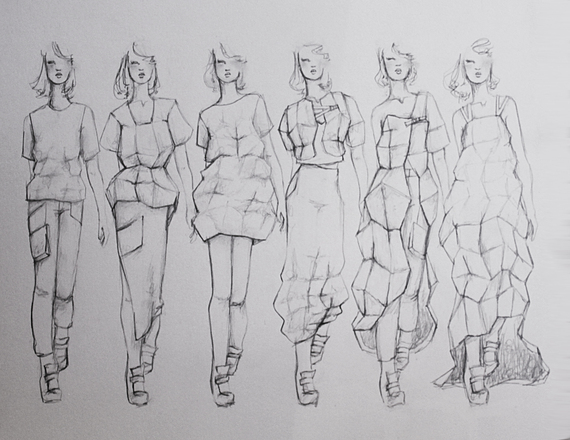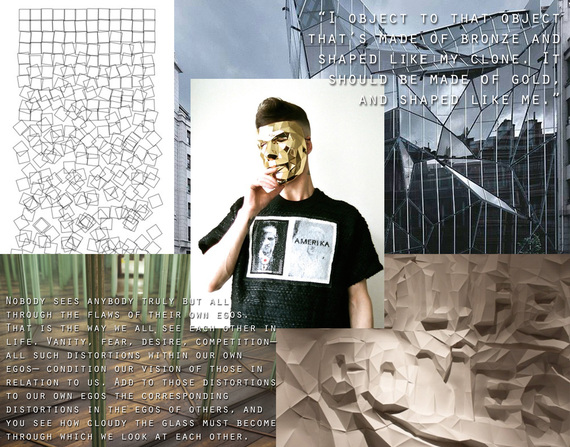For my senior thesis at the Savannah College of Art and Design (SCAD), I created a conceptually-driven womenswear collection of sculptural, gold-foiled pieces which I called "Delusions of Grandeur." The concept was a satirical exploration of the shamelessly self-obsessive tendencies of my generation, thanks to social media. The most well-received piece, named the "VAINGLORIOUS" dress, has (ironically) spent most of the year in the limelight, most recently at SCAD Hong Kong's premier Fashion Show.
![2015-03-07-1425696722-8714979-SCADHongKongGoldDress.jpg]()
I initially got the idea for the concept when my roommate moved out and took the giant hallway mirror with her, one I had developed a habit of staring into every time I walked down the hall. It was disorienting. I realized that the obsession with my own reflection would make an interesting case study, and was something I could really dig deeply into for my fashion collection.
I read an article that said seventy percent of Americans rate themselves as "Above Average" in beauty, a statistical impossibility. This vanity is even more evident when I scroll through the hundreds of selfies I see posted on my Instagram and Facebook feeds. The hallmark of my generation has been our obsession with meticulously constructing our online personas, which fascinates me because we are the first to grow up with the option to use technology to design what we want our lives to look like from the outside.
![2015-03-07-1425696861-2416583-selfie.jpg]()
I chose to make my entire collection as reflective and flashy as possible, begging to be gawked at. I originally thought I would use silver to reference the mirror, but my mentor suggested that a collection based around vanity needed to be made in my favorite color. Making the switch to shades of gold was when everything clicked. I had hoped that the hand-foiling technique, as well as constructing the pieces out of geometric shapes rather than just letting the fabric drape and warp, would allow the viewer to see their mirror image in the garments. While the foil didn't turn out as reflective as I'd originally planned, the process of painstakingly measuring each individual shape and foiling them individually--the final gown had around 200 pieces--was an endless reminder of all the time that I, and I'm sure most everyone else, spend editing every minute detail of our Facebook profiles and Instagram feeds, aiming for a perfect representation of who we think we should be at that moment.
![2015-03-07-1425697887-5105245-Screenshot2015030619.11.45.png]()
![2015-03-07-1425698629-3517885-seenyur.jpg]()
Another inspiration for my collection came from my very first fashion class I took at SCAD, where I learned about Deconstructivism. Philosophically, the concept holds that "meaning is measured in differences," or as the philosopher Paul Ricoeur's famously put it, "existence is interpretation." The way in which I take in my experience and interpret it is going to be different from everyone else. While this concept can seem alienating sometimes, I also think it is very empowering to believe that I, as an individual, have a unique worldview. Maybe by finding the courage to be narcissistic, and believing that my ideas could be important enough to share with anyone who wants to look, I could spark a new idea in someone else. In the final collection pieces, I meant to start a conversation with the viewer by manipulating the shapes to form a single word into each garment--words like self-loving, shameless, and delusional.
![2015-03-07-1425696927-2327213-HannahAmundson2.jpg]()
I think it's important for me to remember that that's all that art is really meant to do--to start a conversation. Fashion is a way for me to interpret thoughts and feelings that I can't quite express any other way. Rather than arriving at a solution though, these questions remain open-ended. Contrary to concept, it has been much more revelatory of the collection's purpose for me to hear other people's opinions on how they interpreted the piece or my design decisions. This realization could not have more perfectly concluded a year-long study of solipsism.
![2015-03-07-1425698318-991454-moodboard.jpg]()

I initially got the idea for the concept when my roommate moved out and took the giant hallway mirror with her, one I had developed a habit of staring into every time I walked down the hall. It was disorienting. I realized that the obsession with my own reflection would make an interesting case study, and was something I could really dig deeply into for my fashion collection.
I read an article that said seventy percent of Americans rate themselves as "Above Average" in beauty, a statistical impossibility. This vanity is even more evident when I scroll through the hundreds of selfies I see posted on my Instagram and Facebook feeds. The hallmark of my generation has been our obsession with meticulously constructing our online personas, which fascinates me because we are the first to grow up with the option to use technology to design what we want our lives to look like from the outside.

I chose to make my entire collection as reflective and flashy as possible, begging to be gawked at. I originally thought I would use silver to reference the mirror, but my mentor suggested that a collection based around vanity needed to be made in my favorite color. Making the switch to shades of gold was when everything clicked. I had hoped that the hand-foiling technique, as well as constructing the pieces out of geometric shapes rather than just letting the fabric drape and warp, would allow the viewer to see their mirror image in the garments. While the foil didn't turn out as reflective as I'd originally planned, the process of painstakingly measuring each individual shape and foiling them individually--the final gown had around 200 pieces--was an endless reminder of all the time that I, and I'm sure most everyone else, spend editing every minute detail of our Facebook profiles and Instagram feeds, aiming for a perfect representation of who we think we should be at that moment.


Another inspiration for my collection came from my very first fashion class I took at SCAD, where I learned about Deconstructivism. Philosophically, the concept holds that "meaning is measured in differences," or as the philosopher Paul Ricoeur's famously put it, "existence is interpretation." The way in which I take in my experience and interpret it is going to be different from everyone else. While this concept can seem alienating sometimes, I also think it is very empowering to believe that I, as an individual, have a unique worldview. Maybe by finding the courage to be narcissistic, and believing that my ideas could be important enough to share with anyone who wants to look, I could spark a new idea in someone else. In the final collection pieces, I meant to start a conversation with the viewer by manipulating the shapes to form a single word into each garment--words like self-loving, shameless, and delusional.

I think it's important for me to remember that that's all that art is really meant to do--to start a conversation. Fashion is a way for me to interpret thoughts and feelings that I can't quite express any other way. Rather than arriving at a solution though, these questions remain open-ended. Contrary to concept, it has been much more revelatory of the collection's purpose for me to hear other people's opinions on how they interpreted the piece or my design decisions. This realization could not have more perfectly concluded a year-long study of solipsism.
